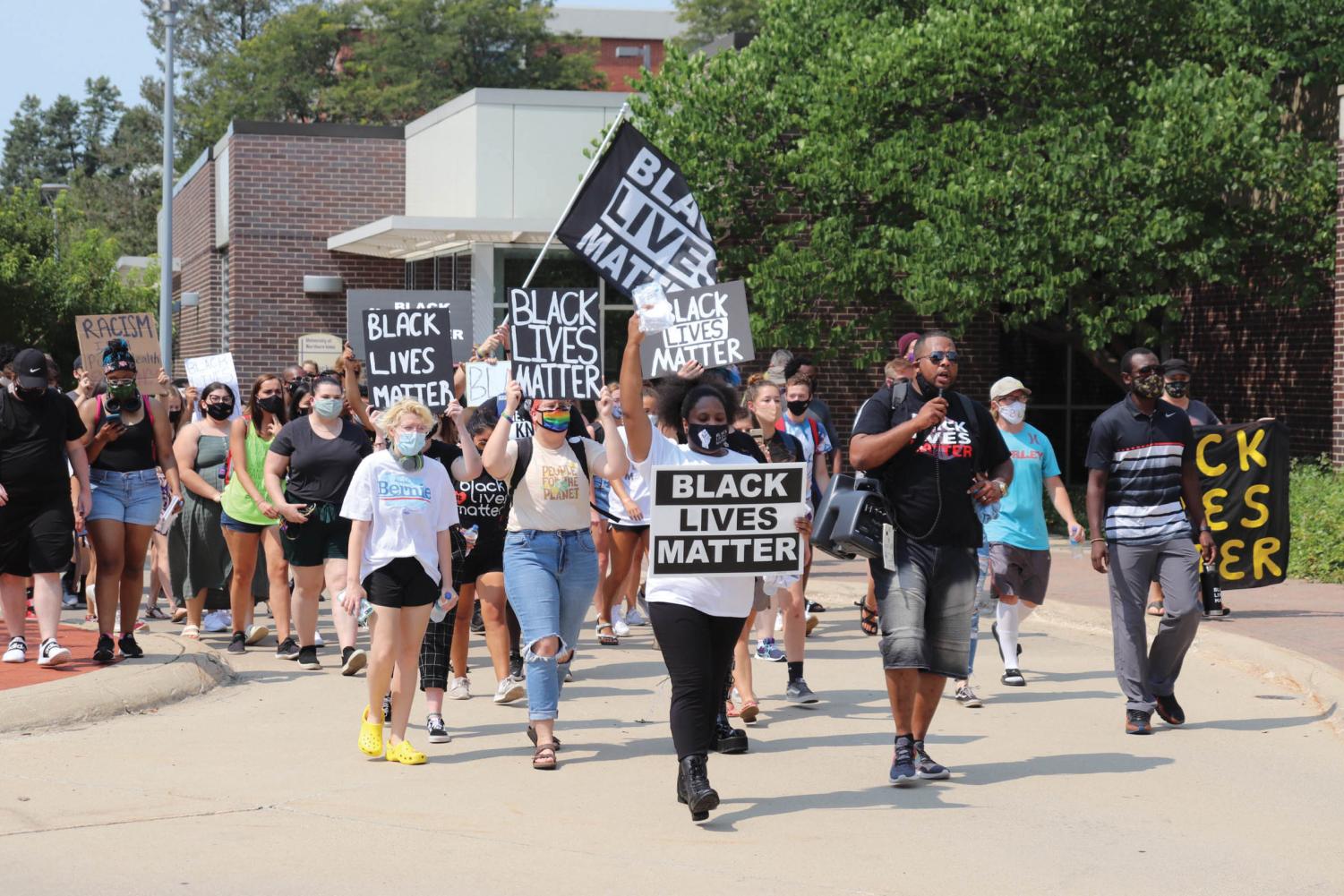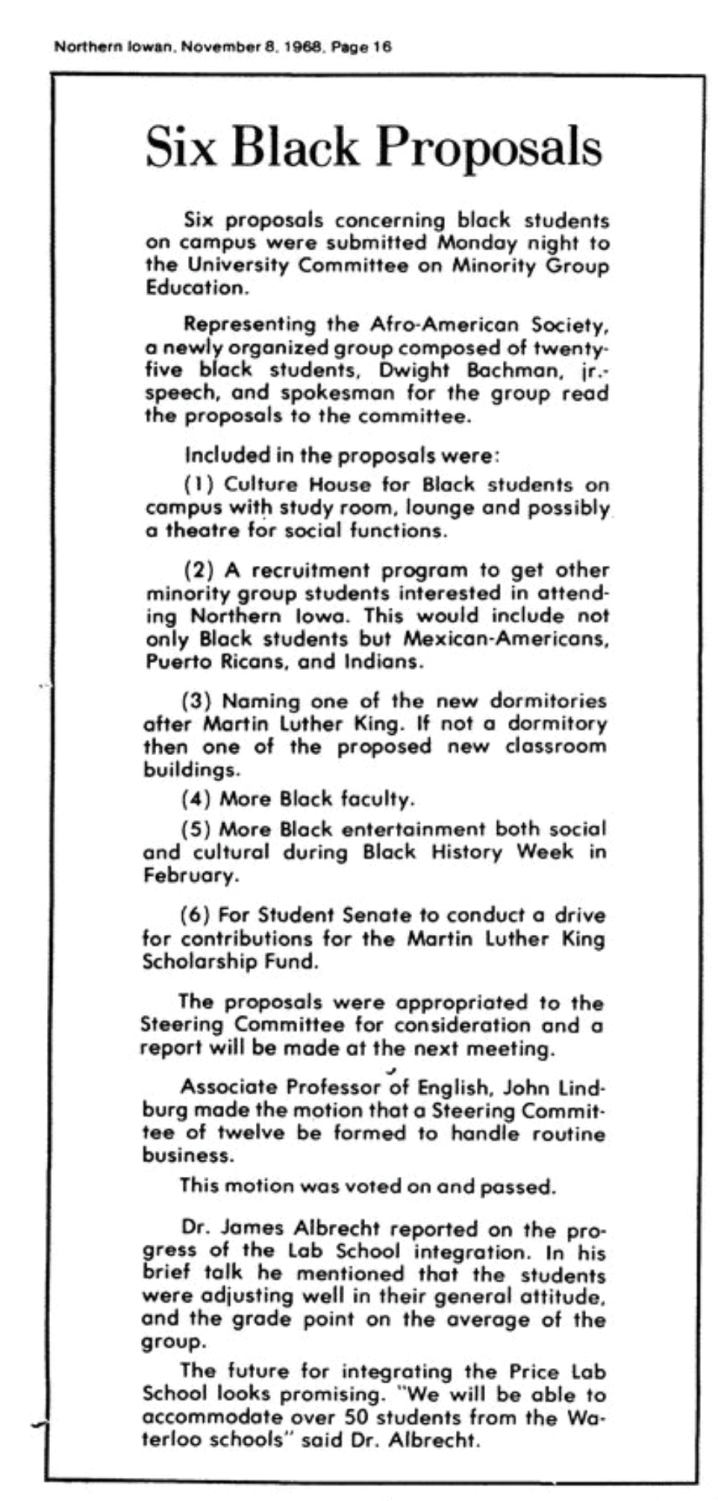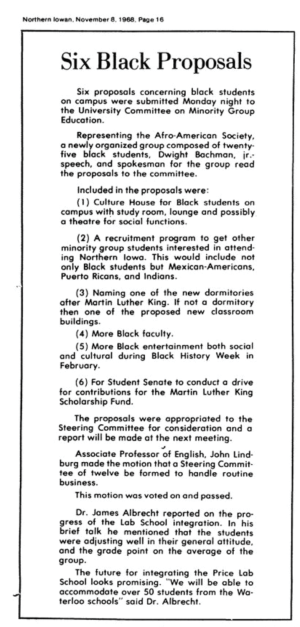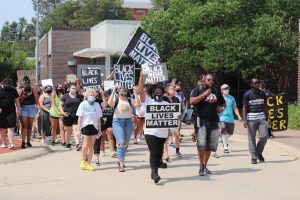The ongoing legacy of the UNI Seven
Feb 13, 2023
More than 50 years later, how has UNI responded to the demands of the first Black group on campus?
In March 1970, seven students from the Afro-American Society at the University of Northern Iowa gathered at President James W. Maucker’s house on a Monday night to ask him a question — the seven of them, six Black and one white, did not emerge until Tuesday evening, with the peaceful protest resulting in those involved later getting arrested and suspended. They became known as the UNI Seven, and were pioneers for change.
The question was about a proposal from a group of Black students called the Afro-American Society for a designated culture center on campus. When they heard it was not included on the Iowa Board of Regents agenda — and the issue of parking was — they went to Maucker’s home to ask him why. When Maucker provided little to no answers, the students decided not to leave until he made some kind of decision.
The development of a culture center for minority students was one of six proposals made by members of the Afro-American society, in a list that was published in the Northern Iowan. The list included having a culture house, implementing a minority recruitment program, naming a dormitory after Martin Luther King, Jr., increasing minority staff, having more social and cultural events during Black History Month and for the Student Senate to conduct a drive to raise money for the Martin Luther King Scholarship fund.
This list of demands was published in 1968, while the sit-in occurred in 1970. So what progress has UNI made with satisfying these demands, decades later?
Creation of the Center for Multicultural Education (CME)
The list of six proposals were presented to the University Committee on Minority Group Education in 1968. Dwight Bachman was the spokesman from the Afro-American Society who delivered these proposals to the committee.
The first item on the agenda is the creation of a culture center. The sit-in conducted by the UNI Seven was instrumental in putting this action finally into place.
After the sit-in, change was not immediate. The participants faced repercussions, but President Maucker ultimately worked on a proposal for Vice President Lang’s house to become the cultural center following his retirement.
It was passed by the Board of Regents, and Lang’s home became the Ethnic Minority Cultural and Educational Center (EMCEC). It officially opened in 1971. The name changed in the 1997-1998 academic year, where it became Multicultural Education.
In 2003, it was moved to Maucker Union, because of the history and the role that President Maucker played in finally getting a designated culture space to come to fruition. The Center for Multicultural Education (CME) has been in Maucker Union ever since.
Having a quiet gathering space, resources and faculty, the CME is a place of refuge for minority students. It is a place for resources, camaraderie, and for marginalized students to work with staff who look like them.
Implementation of a Minority Recruitment Program
The second proposal was to create a minority recruitment program, to get other marginalized students interested in coming to UNI. Admissions does have a recruitment program, but it is not at its highest potential.
Chiquita Loveless, director of Diversity, Inclusion and Social Justice, said, “There is a recruitment program, but it is not as strong as it should be.”
UNI is a primarily white institution, with 7,784 of the students from the 2021-2022 academic year being white. In comparison, there were 1,387 students of other races in the same year. In order to make UNI more diverse and increase these numbers, the minority outreach program needs to be focused on and strengthened.
MLK Dedication
The third demand on the list was to have a dormitory named after Martin Luther King, or a new classroom building named after him. The fifth demand was to conduct a drive for funds to add to a Martin Luther King scholarship.
As most UNI students know, both of these never happened. The University of Northern Iowa has 10 current affiliated residences for students, and none of them were ever dedicated to Martin Luther King, Jr.
There is a tribute to King in Lang Hall, commemorating the time that he spoke there. However, that is the most permanent commemoration that King or any other members of the Civil Rights Movement have gotten on campus.
The scholarship opportunities available to Black and marginalized students on UNI’s campus can be significantly improved. Loveless explains that there is not a stable scholarship for marginalized students yet, but she hopes there will be a larger and better one.
“My goal is to work with senior leadership to ensure that we bring a scholarship for our marginalized students to fruition,” Loveless said.
Increasing Black Faculty
The number of Black faculty on campus has always been a topic of discussion, as the number of current Black faculty is not as high as it should be.
“We need more Black and marginalized faculty on campus to support our marginalized students,” Loveless said. “Students need to see someone who looks like them.”
For the Black and marginalized faculty that is present on UNI’s campus, there tends to be a large turnover rate and keeping them at the university is a struggle. Gwennette Berry, the chief diversity officer at UNI, said, “We have reviewed various methods for recruiting and retaining more faculty of color but it simply hasn’t been successful, but we aren’t sure why. We know this is an area we must work on.”
Berry also detailed how part of her position is helping departments identify methods that will help them find and hire faculty of color. It is an ongoing process, but Berry knows that it is extremely important to the marginalized students on campus.
“We’ll have to hire differently, finding ways to make our environment one where traditionally marginalized populations feel welcomed,” Berry said.
Where the CME is at Now
When the Afro-American Society dissolved in 1972, the Black Student Union (BSU) was formed, and is still active on campus today. They play a critical role in providing a sense of community for Black students at UNI, and host a lot of the events during Black History Month.
“We have a plethora of events and programming during Black History Month,” Loveless said. “We have made major improvements with that.”
Sashay Carroll, an associate producer at CNN and UNI alum, worked at the CME and was an active participant in the center’s events during her time in college.
“It was a safe space for me to experience that sense of camaraderie and that sense of community,” Carroll said. She looks back on her experience with the CME extremely positively. There is no question that the CME is providing a place of refuge, a safe haven for marginalized students on campus.
Since UNI is a predominantly white institution (PWI), the CME is critical to providing marginalized students with a sense of belonging and to make sure that they feel comfortable and welcomed.
Room to Improve
While there have been improvements to the campus culture in the many years since the sit-in, there is still a lot of progress to be made. Injustices are still happening, and changes still need to happen.
In 2019, a student campaign entitled “UNI is Not an Ally” was launched in reaction to how Black students were being treated on campus. Carroll was a voice in this campaign.
“The purpose of the campaign was to give a voice to students of color on campus,” Carroll said, “and to try to change the climate on campus for students of color.”
This campaign was not the first. The changes seen after this campaign are long-term, but the campaign was needed to hold staff and administration accountable, Carroll said.
Resources for Black and minority students also need to be improved. “I think it should be broader than just the CME providing these resources,” Carroll said. By increasing minority faculty and changing the campus environment, the resource distribution would be able to expand.
Changing the campus climate for all minority students starts with the students and the staff. It expands beyond race, it also includes gender and sexuality discrimination as well.
“If we want to keep doors open, we’re going to have to think about equity, inclusion and diversity very hard,” Berry said.
While strides have been made since March of 1970, there is still a lot of change that needs to happen within staff, administration and on campus.
“We have to let our upbringing, our prejudice, and our biases go,” Loveless said, “so that we can allow our future to be light and not carry a spirit of oppression, suppression and depression.”











